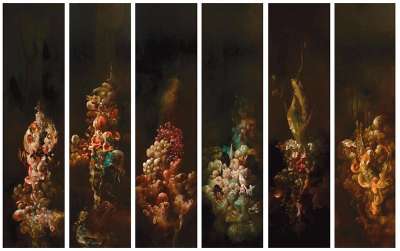“Wait, what in the world is that?”
In art, as in nature, the familiar attracts us. We feel a certain security in being able to recognize and identify things. We can breathe a sign of relief and say, “Oh, that’s what that is!” The Boston-based artist Nicole Duennebier plays around with this proclivity, introducing her wild conjurings under a familiar guise.
The series Hydnellum Myriorama is a six-paneled polyptych. The title refers to a genus of tooth fungus and to Myriorama, a Victorian card game that involves the re-arrangement of images. The paintings lure us in by presenting formal compositions reminiscent of masterful seventeenth century Dutch still-life paintings. The focal points of the paintings emerge from a pool of black, setting off the sumptuous colors of these glistening, floral-like arrangements. Upon closer inspection, however, things become familiar in a different way. Yes, there are ribbons, petals, and berries, but maybe those berries are actually fish roe. And, there is no doubt, the ribbons look like viscera. Crystals and mollusks protrude out of the bouquets. And what is that fluid oozing from these primordial conflations?
Duennebier was born in Connecticut, attended the Greater Hartford Academy of the Arts, and graduated from the Maine College of Art in 2005. Fascinated with biology, her thesis work was influenced by research on the coastal ecosystems of Maine. She says of her inspiration: “Natural phenomenon – dermoid cysts, fungus, invasive flora/fauna – and my love of candied, old-master opulence have a constant presence in my work. Through painting with attention to detail, I’ve become accustomed to the fact that nature itself, or anything living, really, never totally allows you to have a perfectly realized experience. Everything is always spewing, dripping, rotting a little.”
The organism clusters that Duennebier braids together pulse with life – a life defined by growth and decay. These beautifully executed amalgamations seem to beg the question: If you could design a biomorphic bouquet, what would it look like?


